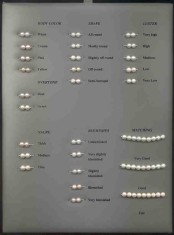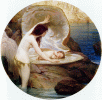 We
follow the cultured pearl value standards provided by the Gemological
Institute of America (GIA) and The Guide for Grading Akoya Cultured
Pearls by Gemworld International, Inc. We use the G.I.A.
Gem Pearl Master Comparison Set (to see the comparison set, click
here) to actually compare with the pearls we grade. The G.I.A.
Gem Pearl Master Comparison Set was developed by Gemworld
International, Inc. and International
Cultured Pearls of The Orient, Inc. for G.I.A. and exclusively
provided by G.I.A. We
follow the cultured pearl value standards provided by the Gemological
Institute of America (GIA) and The Guide for Grading Akoya Cultured
Pearls by Gemworld International, Inc. We use the G.I.A.
Gem Pearl Master Comparison Set (to see the comparison set, click
here) to actually compare with the pearls we grade. The G.I.A.
Gem Pearl Master Comparison Set was developed by Gemworld
International, Inc. and International
Cultured Pearls of The Orient, Inc. for G.I.A. and exclusively
provided by G.I.A.
Akoya is
the Japanese word for salt water. In the jewelry trade, Akoya
pearls or Akoya cultured pearls are known as salt water cultured
pearls.
What does the "Letter Grade" mean?
There are no standard or objective grading systems for pearls.
Every company can establish their own system. Proper grading
is done by comparing pearls against a master comparison pearl
set.
G.I.A. lists six value factors for pearls: luster, nacre thickness,
surface quality, shape, color, and matching.
Pearl worth depends on the combination of these six value
factors and the "letter grade" is an attempt to give
a single designation that fairly expresses the combination of these
six factors.
All the pearl jewelry at Pearl Oasis has a "letter grade",
but we also list our determination for each of the six factors.
If you go to the "details" page of an item, you will see the
grading for each of the six factors.
Below is a brief introduction of the Akoya pearl grading
system we employed along with what each of the six factors
must be to earn a given "letter grade".
| Grade |
Luster |
Nacre
Thickness |
Surface
Quality |
Shape |
Color |
Matching |
| A to A+ |
Medium |
Thin |
Noticeable
Blemishes |
Slightly
Off Round
to
Mostly Round |
White, Medium Cream, or Pink Body Color
with
Rose, Gray, Green
Overtone |
Good |
| AA |
Medium
to
High |
Medium |
Slightly
Blemished |
Round |
White, Light Cream, or Pink Body Color
with
Rose, Gray, Green
Overtone |
Good
to
Very Good |
| AA+ |
High
to
Very High |
Medium
to
Thick |
Slightly
to
Very Slightly
Blemished |
Round |
White, Light Cream, or Pink Body Color
with
Rose, Gray, Green
Overtone |
Very Good |
| AAA |
Very High |
Thick |
Very Slightly
Blemished |
Round |
White, or Pink Body Color
with
Rose, Silver
Gray
Overtone |
Very Good
to
Excellent |
Note that Pearl Oasis does not carry A to A+ grade Akoya cultured
pearls. The following is a detailed explanation of each factor.
Pearl Luster
Pearl luster is the surface brilliancy of pearls. It is probably
the best expression of a pearl's beauty. Luster does not simply
mean a shiny surface It implies the structural beauty of the nacre.
We grade pearl luster in six levels: Very Low, Low, Medium, High,
Very High and Excellent. Pearls with a very high luster will generally
show strong and sharp light (mirror like) reflection of the light
source. AAAA and AAA grade Akoya pearls have excellent to very
high luster. AA+ and AA have high to good luster. A+ and A grade
pearls have medium luster. Pearls with a very low luster
look very milky or chalky. They show very little highlights. Pearl
Oasis rejects pearls with very low luster.
Pearl Nacre Thickness
Nacre is the coating that the oyster forms around the nucleus
of the pearl. Nacre thickness is more than the amount of nacre.
It has other meaningful aspects as well. The structure of the nacre
is composed of thousands of layers of thin calcium carbonate crystals.
This distinctive nacre structure influences the color, luster,
durability and elasticity of the pearl.
AAA
grade Akoya pearls have very thick nacre. AA+ and
AA grade pearls have medium thick nacre. A+ and A grade
pearls have thin nacre. Pearls with thin
nacre allow the core nuclei to be seen through the nacre. Pearls
with thin nacre often exhibit visible cracks in the nacre. Pearls
with thin nacre can also display signs of nacre peeling or chipping.
Pearl Oasis rejects such pearls and we do not carry them.
Pearl Surface Quality
All the factors that disturb the surface smoothness of the pearl
and hence decide its appearance are called blemishes and imperfections
(also called spots or flaws). The quality of the pearl is greatly
affected by blemishes. Natural blemishes are formed during pearl
cultivation. By definition, a blemish is anything that can be seen
by unaided eyes.
When grading an individual pearl (for a pearl ring, or pearl pendant,
for example), the degree of blemish is divided into clean, slight
spot, medium spot and heavy spot according to number, size, kind
and location of the blemish. We reject pearls that exhibit excessive
amounts of blemishes, such as cracks throughout the pearls, prominent
flaws in a single pearl, patches of missing nacre, obvious discoloration's
throughout the pearls, and flaws which cover the majority of the
surface of the pearls.
When grading a whole strand of pearls (for a necklace, for example),
we determine what percentage of pearls have blemishes. The less
such pearls the better quality of the strand. We grade surface
quality of a pearl strand by determining what percentage of pearls
have blemishes. AAAA and AAA grade Akoya pearls are unblemished
to very slightly blemished pearls. AA+ and AA grade pearls are
very lightly blemished to slightly blemished pearls. A+ and A grade
pearls are noticeably blemished. For a strand
of pearls, 0-5% pearls with blemishes is considered unblemished
to very slightly blemished. 10-20% is very slightly blemished,
20-30% is slightly blemished to lightly blemished. We reject pearl
strands that have more than 40% of the pearls with blemishes.
Pearl Shape
When it comes
to round shape, no other cultured pearl can compete with the
Akoya cultured pearl.
We grade
pearl shape into five levels:
- Semi-baroque and baroque
- Off round
- Slightly off round
- Mostly round
- Round
Semi-baroque and baroque are pear-shaped
or irregular shaped and are listed separately. Off-round pearls
have flattening on one side or are oval.
If the pearl's shape is graded less than round, the pearl will
only qualify for grade A+ or A. Only round pearls will qualify
for a grade of AAAA, AAA, AA+, or AA.
Pearl Color
Pearl color
is a combination of body color and overtone. Body color is the
predominant basic color of the pearl. When pearls lay on a white
surface, body color can be best seen on the outer edge of the
pearl. Body colors include white, light pink or pink, light cream,
medium cream and dark cream, yellow or golden. Overtone is one
or two colors that overlie the body color. When inspecting pearls
under light, you may see color in the central dark areas of the
pearls. This is the overtone. Overtone colors include rose, gray,
and green. You should remember that pearl color for the purposes
of grading is not a measure of the beauty of pearls or your choice
of pearl color. Pearl color relates to an aspect of pearl quality
measured by pearl color. It is important to remember that what
color of pearls is the most desirable in one market or culture
may not be desirable in another.
With Akoya
cultured pearls, the color and intensity of the color is a distinguishing
feature of pearl quality. Low quality pearls often have brown
or yellowish body color and do not have overtone or very poor
overtone. Pearls without overtone look "flat". High
quality pearls have deeper overtone color, because the intensity
of color is the result of thick nacre and high luster. Pearl
processing also effect pearl color.
Generally,
Akoya pearls have four basic body colors: white, cream (ranging
from light, medium or dark), pink and yellow and three overtones:
rose (pinkish), light green and gray. AAAA and AAA grade Akoya
pearls are white or pink body color with rose or gray overtone.
AA+ and AA grade pearls are white, or light cream body color with
rose, gray or light green overtone. A+ and A grade pearls are white,
medium cream, or pink body color with rose, gray or green overtone.
Akoya pearls with dark cream, or yellow body color are lowest quality
and are not used by Pearl Oasis.
Pearl Matching
Matching
refers to how closely two or more pearls are similar in luster,
nacre thickness, surface quality, shape, and color plus
size of the pearl. Matching
applies to pairs of pearls and strands of pearls but does not apply
to jewelry with a single pearl. AAAA and AAA grade Akoya pearls
are excellent to very good matching. AA+ and AA grade Akoya pearls
are very good to good matching. A+ and A grade Akoya pearls are
good matching. We do not accept poorly matched pearl pairs or strands.
Put All Pearl Factors
Together
Pearl worth
depends on how one combines the complete mix of these six value
factors. Two strands of pearls of exactly the same size maybe
very different in other factors such as different color, different
surface quality. Additionally, not each of the factor are weighted
same. According to Gemworld International's Pearl Guide, the
following percentages apply to the six factors except size:
Luster 25%
Nacre Thickness= 25%
Surface quality = 20%
Shape = 15%
Color
= 10%
Matching = 5%.
Total
100%
Pearl Size
While pearl size is not one of the six quality factors, it is
a component of the "matching" factor. For Akoya cultured pearls, size means
the pearl's diameter measurement. Pearl size is expressed in millimeters,
rounded to the nearest 0.5MM. Akoya cultured pearls range from
2MM to 11MM. Most common sizes are from 5MM to 8MM. A 10MM Akoya
is uncommon, and an 11MM Akoya is rare.
In a strand of pearls, if individual pearls are within the .5mm
range, they are considered the same size. When you see a size range
like "6.5 to 7mm", it means that no pearl in the strand will be
less than 6.5mm or greater than 7mm.
Generally, if other value
factors are equal, the value of Akoya cultured pearls rise
with their size. However, small size akoya cultured pearls can
cost more than larger sizes.
The larger the size of an akoya cultured pearl, the more difficult
it is to produce a pearl with high luster, nacre thickness and
good surface quality.
To
help you visualize how big a 7MM pearl is, see our Pearl
Size Page.
|




